-
"This ghastly indie-art-game prose: it’s writing that tries to communicate ideas in the same way that game mechanics communicate ideas. Such writing offers allusions and suggestions, hints for the player to assemble, but it shies away from specifics or a through-line plot. Characters often go unnamed, or are named something thuddingly symbolic, or are Everyman. Theme is presented heavy-handedly (you wouldn’t want players to miss it!) and via the most cliché images. Expect frequent references to light and dark, cold and loneliness, broken hearts and shattered dreams. Memories may get a look in. Also death. It’s like reading a collage of the manuscripts sent to a high school poetry contest right after one of the students got in a fatal crash." Emily is right, and it's something I hate about certain games: just how *self-consciously* "indie" they are.
-
"While everyone else is going sleek and elegant and natural, Tiger is all experience points and loading screens and instant challenge pop-ups and club-tuning holodecks. Skate feels like skating, Fight Night feels like boxing, and Tiger feels like a game about golf." I don't like golf; I love computerised golf. I don't like Tiger; I love Links in all its forms, and before that, Leaderboard. This is a brilliant – if long – piece of writing on a short history of PC golf, and what's wrong with Tiger in this day and age. (Apart from, you know, the whole sex-addict thing).
-
"I've always marvelled at the idea of a $25m game needing $35m of marketing. Doesn't that feel so wrong and weird? I'd make two $25m games, spend $8m on indies doing crazy new things, and have $2m left over for some nu-style publicity. Or better still, spend $60m across 60 indies full stop." Lots of good things in Alice's compainon to Matt's posts, but especially this; the constant shyness to 'spend less on more stuff' from the games "industry" always befuddles me.
-
Lots of comics neatly surmising the plots of various Metal Gears; "Let's Destroy The Shagohod" is pretty spot-on, start to finish, and full of Giant Spoilers, obviously.
-
"As I tried to unravel Braid’s interstitial text I realized that solving the puzzles and understanding the text required very similar approaches. Their concealed machinations and thematic ambiguities are teased out using the same mental processes, and are part of the same overarching search for meaning. In a way, I was “reading” everything in the game. It’s not the unification of narrative and gameplay that we’ve come to expect, but it’s a refreshing and effective one." Dan Bruno has an interesting perspective on Braid; not sure I agree with it entirely, but the feelings he describes are certainly familiar.
-
So I'm going to be writing the odd thing for Offworld from time to time, and this is my first post, on a nice post from Steve Gaynor about architecutre, and leading players through stories with architecture alone. More to come, pop-pickers.
-
"A decade or two ago I spent some days in a “study” in an old Oxford college: bed, desk, lamp, and a window with a view of the quadrangle; nothing else. It made an impression that hasn’t faded. Among other things, I made insane, immense progress on a difficult piece of writing at the front of my to-do list. Here’s a prediction: Geek fashion in particular and intellectual fashion in general will swing hard over: from cluttered to ascetic, from high to low entropy, from library to monastery." A few thoughts from Tim Bray – not all of which I agree with – on the changing geek aesthetic.
-
David Hellman releases hi-res assets of all the Braid artwork. It is beautiful, and am thinking about how best to use some of it on my desktop.
Favourite Games of 2008
24 December 2008
It’s the end of the year, and that means time for lists. My books and albums lists are forthcoming – hopefully tonight or tomorrow – but in the meantime, I thought I’d kick off with ten of my favourite games of the past year.
There’s lots missing here, mainly owing to the fact I haven’t finished a lot of recent titles or given them the time they’ve deserved. What this is, though, is a good summary of what the gaming year felt like to me; ten games I enjoyed a great deal, and that I would recommend in a heartbeat to anyone not sure where to begin with 2008.
And so, in no particular order:
Far Cry 2
(Xbox 360, PS3, PC)

I have written enough about this already, but suffice to say: it sunk its teeth into me, after the initial hump I couldn’t play anything else, and at the end, it left me unable to play anything else for a while. Spectacularly beautiful, too.
Trism
(iPhone)
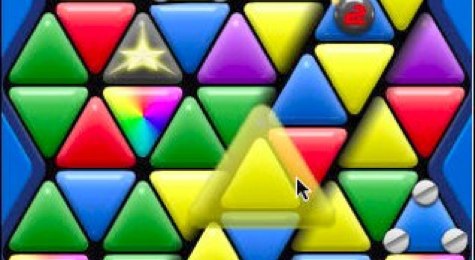
Trism began as an app for the jailbroken iPhone; it quickly made the transition to the official App Store platform when that opened up, and it has sold hundreds of thousands of dollars of copies since then, giving Demiforce a fantastic start to their company. And with good reason: it’s a great piece of game design, easy to learn, and hard to master. It also makes brilliant use of not only the iPhone’s capacitive touch screen, but also its tilt sensor. It’s a very pure puzzling experience, and I’ve already sunk many hours into it; it suits the pick-up/put-down rhythm of travel and play on-the-move idaelly. If you have an iPhone or iPod touch, this really is a no-brainer.
Geometry Wars Retro Evolved 2
(Xbox 360)
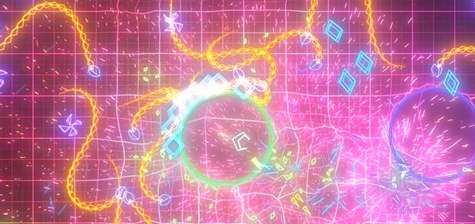
It’s still one of the best games on Live Arcade. It’s also still one of the best asynchronous multiplayer games you can play. Making your friends high scores the default high score table gives it a great competitive streak and really contextualises your performance: nothing’s more frustrating than having emailed a friend to say “hah, beat your high score” only to receive an response five minutes later informing you that the ball is firmly back in your court.
Adding variety to the original formula are the six game modes, slowly unlocked over time. They may all be variants on a theme, but they all still demand unique skills and become games in their own right: turning the Pacifism achievement from the first game into a mode in its own right was a great move.
Beautiful in high-def, easily explained to anyone who’s played a videogame in their life, it’s by turns accessible and challenging, and an essential purchase for new 360 players. Also, its social scoreboards give it great longevity, and prove what I already know: I’m nearly, but not quite, at the bottom of the pack when it comes to motor control. As long as I’m not last…
Braid
(Xbox 360)

If there’s a measures of Braid’s success, it’s not to be found in its sales or metacritic scores, but in the sheer volume of verbiage devoted to it in the blogs, forums, and magazines of the gaming world. Thousands of words, all expended on the game, on the hype, and on what the hell it all means.
It wouldn’t have got that discussion if it wasn’t in some way good, and it really is: beautiful, challenging, and proof of the things that only games can do. It embraces game-native storytelling, wrapping its meaning tightly around its mechanics, and tells its tale through challenging, timeless puzzles and David Hellman‘s incredible artwork.
Perhaps it is a little pretentious; perhaps the writing is weak. Regardless of those facts, it’s exciting to see a game like this getting such a major launch on a mainstream, living-room platform, and as an artefact to push forward the casual – as well as professional – criticism of games, it’s a great starting point.
GRID
(Xbox 360, PS3, PC)

I always forget how much I like racing games. GRID is a very, very fine take on the racer. It’s beautiful, it’s fast, and it’s totally stripped down. GRID demonstrated that Codemasters really understood what making a game “cinematic” might look like: you condense it down into tight, exciting drama. So races take place over two-to-five laps, and in that time the AI will give you as good a catfight as any “realistic” simulator might over an hour. The rewind-time mechanic, as well as being wonderful to watch, removes the traditional racing-game reliance on the “restart” option; giving the game a pre-credits race, not to mention an ongoing narrative of running a team only helps with the Days of Thunder feel. Mapping Le Mans to a twenty-four minute endurance race makes it both exciting and endurable.
And, of course, it’s very pretty and fast as hell. The open-wheel racing is some of the most exciting driving games have to offer, in particular. The drift tournaments are weak, but stick to the touring cars, touge and open-wheel and you’ve got a hell of a game. The icing on the cake is the beautiful, free-floating typography. Solid, and surprisingly good.
Grand Theft Auto IV
(Xbox 360, PS3, PC)
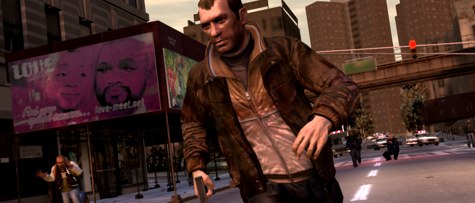
It’s on everybody else’s list, and I can’t really deny it: it’s a wonderful environment, and a staggering achievement. It’s not as smart as it likes, and it occasionally misfires but it delivers moments by the dozen. Shame the pacing of the islands feels wrong – after the majesty of Three Leaf Clover, being dumped in the New Jersey analogue is a bit underwhelming.
Also: multiplayer, with the right gang of people, is a total hoot. Whilst not the runaway online success that might have been hoped for, if you can get eight to sixteen friends online together, Cops and Crooks or Turf War will bring the fun pretty fast.
God of War: Chains of Olympus
(PSP)
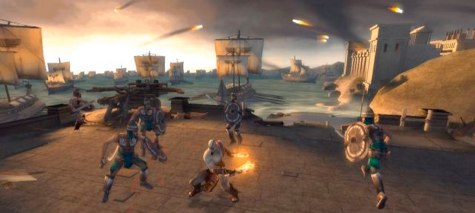
Well, it came out this year in the UK. I played this sitting by a roaring log fire, having spent my days clambering around the Lake District. It is not the greatest game of the year by a long stretch. It is, however, a wonderfully crafted experience: short it may be, but it’s put together almost perfectly: fantastic environments that barely repeat, thrilling combat that’s not too difficult, and one of the most striking in-game sequences I’ve played this year. It helps that the lack of direct camera control translates perfectly to the single-stick PSP. On top of all that, it looks almost as good as the PS2 versions – it’s a remarkable feat of engineering. I had a lot of fun with this, and if you own Sony’s much-unloved portable, you owe yourself to play this.
Left 4 Dead
(Xbox 360, PC)
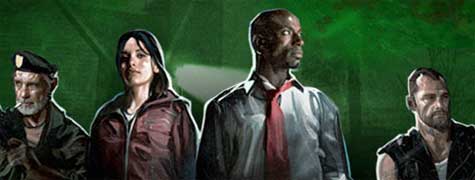
Gerard Way asked if it was any good, and the answer is yes, Gerard, it is. It’s bloody brilliant, although with the obvious caveat that it gets better with friends. Co-op gaming has slowly seen a slew of support and innovation in the past two to three years, and Left 4 Dead represents one particular pinnacle of that: an experience designed ground-up to be played not only co-operatively, but with real friends.
It’s not about team-mates, it’s about mates; how far would you go to save your friends from a Smoker? Quite far, as it turns out; I’ve noticed that in various pick-up groups, if I have to pick between someone I know in real life and someone I don’t, I’ll go with my friends first. To see such an unashamedly co-op experience – and one that could be described as reasonably hardcore if you hadn’t tried it – achieve such a level of mainstream success is very heartening. I put it down to the fact that Valve are such a talented gang of people, and so fastidious in their process. If you’ve not played through the director’s commentary, you owe it to yourself to do so, if only to understand that nothing in the final product is the result of chance.
Also: it’s great to see a game that puts the mechanic, indeed, the core technology, that really makes it – the AI – so far front-and-center. Personifying it as the AI Director was the stroke of genius that not only made players aware of it, but gave them someone to blame when they all died. Again.
World of Goo
(Mac, PC, Wii)
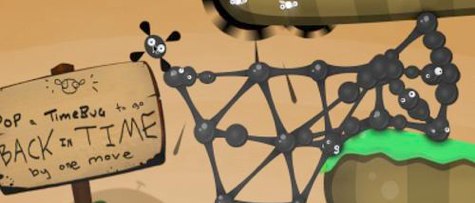
There are two reasons, I think, that World of Goo has captured a lot of people’s hearts this year. One is the game itself: the wonderful art; the delightful soundtrack; the just-one-more-go gameplay that carefully teaches you everything to know whilst keeping the challenge just high enough. But the other is the game’s mythology: 2D Boy, two guys working out of coffee shops for a year, giving up on the traditional industry to make the game they really wanted to. It’s the story we all wanted to believe in. The fact that both elements are so great is the real magic of World of Goo: risking it all, living the indie dream, really did lead to a wonderful game.
Gravitation
(Mac, PC, Linux)

I like this more than Rohrer’s previous Passage. It’s a small, simple game, available for most home desktop platforms (Windows/OSX/Linux), about “mania, melancholia, and the creative process”. To say any more is to rob it of its impact. Once I worked out what you have to do to progress, I played on with a huge lump in my throat. To be heartbroken by a game this slight, this simple, in its 100 square pixel area, is quite something, and Rohrer makes games like no-one else.
-
"I still consider glass to be an extreme craft – you’re working with and fighting gravity and momentum in those 60 seconds before it starts to harden – but you learn to take your time, even if there are lots of moments of extreme concentration to keep a piece from disintegrating." Chris writes up his glass-blowing course; sounds great.
-
"Perhaps the problem is that we so deeply rely on reference points like film, which require stories progressing over time, when we could be referring to things like sculpture or painting, which require no timescale and people find just as moving." Some good thoughts from Jonathan Blow; I think his point about games' unique ability to challenge is an important one.
-
"Rohrer is trying to make art in a medium that most people don't even think is capable of art. He can create this space of pure freedom, as artists have done in the past — isolation, introspection, ascetic poverty. But ultimately he has to send these works out into the world, and people have to respond to them. And right now the audience doesn't know what to do with them." Fantastic writing from Esquire; mature, sensible, and at no point apologist.
-
"The 'better sequel' mentality is damaging both to the games industry and to the quality of games journalism. It is a deferral of critical responsibility, a patronising pat on the head for the developer who dared to dream and fell short in some mythically vital way. I don't want to be frustrated by dodgy controls either, but then I'm willing to blunder through if I'm going to get an experience I never had before." And this is why I've been sticking with it; I think Keith is on the right lines with this quotation.
-
I really like the dot/tab/pad/board delineation, and the fraction/inch/foot/yard scale that accompanies it. A nice way of framing these issues.
-
"Someday I hope game designers really are seen as trusted personal trainers, and that we have the chance to take people through proven processes that pay off in the long run. More gamesight, a surprising social safety net and support system, a more engaging environment, a higher quality of life." You trust a good designer to deliver good experience, regardless of the pain they put you through.
-
"Unknown games are always the best ones… They are always stronger, funnier, cleverer and better-executed than their realities and so that walk home from the store, when the game is tangible in your hands but still imagined in your mind, is oftentimes the most potent moment in the videogame experience." A lovely piece from Simon on what the end of a certain kind of retail experience will really mean.
-
"Steve Rose notes that the recent films have seen Bond visit and destroy as much villain-architecture as ever ("The villains are the creators; Bond is the destroyer. He's basically an enemy of architecture"), and suggests this can be traced back to Fleming's difficulties with Modernist architects." Rod on Bond is always good, and bonus points for the punning title.
-
"A series looking at different aspects of guardian.co.uk's rebuild and redesign project, which ran from October 2005 to September 2008." Looks like there's going to be some good stuff emerging from this; great to see the Guardian making it so public.
-
"…then, after destroying his nano-network, as an admonition to the audience, extended [Arthur C Clarke's metaphor]: 'Any truly advanced technology is indistinguishable from garbage.'" Excellent summary of what sounds like a wonderful GDC Austin keynote from Bruce Sterling.
-
"'What we've done in MMOs and what we tend to lean toward is building an enviroment for the new player to explore that is essentially a safe environment… the newbie zone. For our explorative learners, we've given them safe zones to explore.' But that doesn't work for imitative learners." Excellent article on styles of learning, with particular attention to how MMOs teach players game mechanics.
-
"Very recently an anonymous poster on /b/ claimed to have hacked Sarah Palin's Yahoo e-mail account." 4chan members get into Sarah Palin's barely-disguised Yahoo mail accounts which she used for business.
-
Oh boy.
-
“I decided to create Flatshare fridge because there is nothing more disgusting than a dirty fridge in a shared flat,” he says. “At the time, I was living in such a flat!” Amazing.
-
"It occurred to me that if I could somehow tether a DSLR to an instant-on device like an Arduino microcontroller I would have less weight to carry around and could get more work done. After mentally spec’ing out what I would need, I realized the solution was right in front of me – because I bring it with me for Mario Kart wireless races on long night jobs – (In the manner of John Lasseter’s slow epiphany voice): “Use-the-Nintendo-D-S.” Duh." Oh wow.
-
Soulja Boy reviews Braid. Oh dear. (Although: much as I want to mock it, he is correct that time-rewind mechanics are, usually, a lot of fun in and of themselves. But still.)
-
"This week’s 1UP FM is a fascinating round table/interview with Jonathan Blow, David Hellman, Rod Humble, and Sean Elliott and Nick Suttner from 1UP… If you’re at all interested in Braid, experimental game design, or the ethics of games you should go listen now." In the meantime, Ben Zeigler has provided some excellent annotation for us all.
-
"Over the last few years, there has been a big shift in power and success away from independent studios, and towards in-house, publisher-owned studios. This has been driven by several things, sound economic reasons, competitive reasons, and because the strong independent studios had done a good job at creating a slew of new IPs (which publishers were eager to snap up, as always). In my experience relatively few people in the games industry realise this… So, what’s next? What’s going to happen over the next 3-5 years?" Adam on the business of the games industry, and what's facing it next.
On Braid and Bullshit
07 September 2008
A quick note: this post is long, and it’s been a lot of work just to bring it down to some kind of coherent structure and size. It perhaps could have been better as a series of posts, but for now, this is the form it takes. I hope, despite the length, that you enjoy it. Shorter content is forthcoming…
I love Braid. It’s a remarkable game that I’m enjoying playing a lot; it’s a game I love to talk about to both gamers and non-gamers; and it’s a game that is always yielding up new insights and interpretations the more I play it. And most importantly, you have to do more than just talk: it’s a game that only really reveals itself through the act of play. Which is, you could say, how all games should be, but it’s still impressive how much Braid concentrates into its mechanics.
Because of the potential for insight it offers, there’s been a lot written about it since its release, and as the amount of writing on Braid grew, I realised that I was growing dissatisifed with much of it, and that I needed to articulate why.
The starting point for this post was a long, invovled forum thread on rllmuk about the story of Braid, which presented a long, coherent (if at times a little sketchy) interpretation of the game as being about the Atomic Bomb.
What frustrated me was the way the author of the post presented it. He began like so:
Braid is a story that focuses on the development and deployment of the atomic bomb, and the irreversible impact it had on all human conflicts thereafter. At the very same time, it deals with the very human story of a relationship breaking down due to one person’s obsessive need to control this power. Finally, at certain points, the perspective of the bomb creator as a child comes through.
As I said: it’s an interesting reading. The commenter has clearly taken a long, careful look at the game, and come to an interesting conclusion. But why does he have to frame it as a solid, single interpretation?
A few posts later, the rllmuk commenter admitted that the unsubtlety of his phrasing was deliberate:
It’s also the absolute proof, if ever such a thing was needed that something like Braid can be any number of things; stylistically, a homage to 2D platformers of old, the play on the hero/princess stories we’ve been sold any number of times over the years, the take on jealously and obsession… I presented my argument the way that I did because it’s the one angle that I don’t think has been commented on yet, and I’m of the opinion that there is sufficient evidence to support it.
This assuaged a lot of my fear – I think, if anything, he pressed on with his take on things even when his reasoning was sketchy precisely in order to illustrate the many ways the game can be read. All credit to him for that.
I’m still playing Braid, but the one thing I’m pretty convinced by is that it’s about more than one “thing”. There’s more than one sensical and valid reading of it, and it supports many that the author may not have originally intended.
(Beyond that, I’m also convinced of two things: firstly, that wherever the game itself takes place, the world “Tim” lives in is our world, not the world he platforms through, and secondly, that Tim plays videogames.)
I’m tired of games criticsm being so cut-and-dry; so focused on what things are about, rather than what they could mean. We’re not so blinkered in our criticism of any other medium, so why do we have to be like this with games? There’s a nice story, wrapped up in that RLLMUK thread – first I’m frustrated with the tone, but everything turns out alright in the end, as the author’s tone is revealed to be another kind of artifice.
Anyhow, like I said, it got me thinking about the way we currently criticise games.
Then, a few weeks ago, Jonathan Blow (who can unarguably be described as Braid’s “creator”) did an interview with the Onion AV Club, and for the first time, he said something that rubbed me the wrong way. Blow is obviously a smart chap, and he has a lot of excellent things to say about games, and what they can be. Until the release of Braid, a lot of this could only be seen as talk, but now he has a platform to stand on – the game itself, released into the world – and it’s exciting to see someone deliver on their promise of an attempt at change: the game espouses his points itself without any illustration.
But I kept returning to that interview, and the passages that rubbed me the wrong way, and I realised that lot of it was about the nature of criticism (not just games criticism, but criticism itself) and that I had to write about it now or lose it forever.
I don’t want this post to be a Fisking of Blow’s interview, because he says a lot of interesting things in it, and I agree with quite a few of them – but it’s the first time he’s said things that I disagree with at a very fundamental level. And it all began with this statement:
I was a double-major in Computer Science and English. And English at Berkeley, where I went to school, is very much creatively-driven. Basically, the entire bachelor’s degree in English is all about bullshitting. And Computer Science, which was my other major, was exactly the opposite of that. You had to know what you were doing, and you had to know what you were talking about.
This is not what I discovered throughout my degree in English literature (and I’m going to assume that by “English” Blow means the study of literature and its criticism, rather than “creative writing”, as it were). The one thing I learned pretty fast is that the last thing criticism is about is bullshitting. I got away with some heinous bullshit as a secondary school pupil, but believe me, my supervisors forced that out of me pretty fast, and I began to learn how to write my own criticism – rather than a condensation of that of others – that stands on its own and, crucially, shows that I know what I’m talking about.
What Blow is describing is a problem I’ve seen many times before, though: the difficulty of engaging with criticism.
Continue reading this post…
-
"I've just added a new feature to the site: maps showing many places at once. They allow you to, for example, see all the churches in London Pepys has mentioned in one glance. Or London streets, or places outside Britain, and more." Some fantastic maps-and-pins from Phil and Sam.
-
"The series "A New Taxonomy of Gamers" wrapped up last Friday. For your convenience, here are the links to all 11 parts in one convenient post." Oh, this looks good.
-
Heard some of this last night; a superb BBC documentary about Brian Wilson and some of his production techniques that shaped the Beach Boys' albums. Some great interviews, and lovely musical deconstruction of harmony and voicing. Obviously, as a "listen again" programme, it's only around for six days – so get listening!
-
"Hired as visual artist in the summer of 2006, my challenge was not only to clearly present Braid's mechanics and behaviors, but to help tell a story that was anything but literal: part anecdote, part artifice, part philosophy. This article explains the process of developing visuals for a nearly-complete game with a highly idiosyncratic identity, the challenges encountered, and some of the nuts-and-bolts of our methods and tools." David Hellman on his work on the art of Braid.
-
Man, SIGGRAPH papers have the best titles. This is a lot of seriously hardcore, cutting edge, graphic-programming nous. Also: "jiggly fluids".
-
"The negative side of this, as your experience illustrates, is that Braid just lacks any immediate sense of fun. It does not set out to entertain you, and with the exception of some pretty aesthetic moments it makes you earn the pleasure you take from it. (Portal, which makes for a good point of comparison, wants the player to like it and desires to be understood in a way that Braid does not.)" I think Pliskin is spot on, here
-
"An interesting article at Rock, Paper, Shotgun tackles BioWare's tackling of issues tackling modern society, tackling one of my Mass Effect plots in the process. I responded in the comments, and after looking at how much I yammered on, I figured it was worth posting here as a look inside how these things get into the game, and why some things that seem dumb get done." Patrick Weekes follows up the RPS post criticising his own plot elements with some frank self-criticism, and some interesting explanations; a reminder of how hard creating any kind of meaningful choice can be.
-
Yes.
-
A blog from Tom, Flora, and no doubt shortly et al, about life in Hackney.
-
Now this *is* interesting: a comments thread in which Michael Abbott's readers put questions to Iain Lobb, one of the designers behind Meta4orce… and he answers them candidly and informatively. Interesting stuff about the limitations of building games around TV shows for public service broadcasters.
-
"I thought it was a parking ticket, and was annoyed. But up close, I saw it was just an empty envelope someone put there…" I'll let you click through for the punchline. Delightful, nontheless.
-
Great selection of posts on how brands need to behave (and how they sometimes fail to do so) from Grant McCracken.
-
Narrative-driven flash game from BBC Switch. Combines animated cut-scenes with minigames representing key plot aspects; as such, it's very linear. Script by Peter Milligan, though! It looks expensive; I'd be interested to know how successful it's been. As it stands, it's a little bit Freakangels-lite, a little bit Torchwood. And yes, I know how that sounds.
-
A nice article about context, contracts, and a few other things related to game AI design. If you're interested in the field at all, it's a nice read.
-
"I believe that the “auteur” school of game development is not only outmoded, but dangerous to the vitality of the medium. Instead, we must pursue deeply collaborative work styles and seek out diverse teammates if indie game development is ever to reach new heights and thrive beyond its current audience." I need to come to a better understanding about auteurship in this field; I'm not entirely convinced by this article.
-
You're a little robot. You're also indestructible. Use bombs to bounce yourself around the level, but don't run out. Lovely little flash game.
-
In which an entertaining man plays a hacked, super-hard Super Mario map, swears at his TV a lot, and still manages to be pretty good at it. It's a nice illustration of the problem-solving process, and it's rather funny. "This is worse than Panic At The Disco. This is worse than Ann Coulter."
-
"The No Game is a party game with only one real rule."
-
This looks like it could be interesting/fun; if anything, worth watching as a slightly more attractive option for lifestreaming…
-
"Sequel Pro is the perfect tool for working with database-driven websites and applications." Leopard-only MySQL management application; forked out of the long-neglected CocoaMySQL.
-
I need to think on this more; there's a lot of meat in it, and some interesting commentary, but suggesting that "the entire bachelor’s degree in English is all about bullshitting things" I find somewhat insulting. I'm frustrated because it feels like Blow is pushing for people to find the "correct" interpretation, rather than any valid criticism they can back up. Still, there's also some excellent stuff in here, but it's the first thing he's said that's rubbed me the wrong way a little (and I'm not just talking about the 'bullshit' comment).